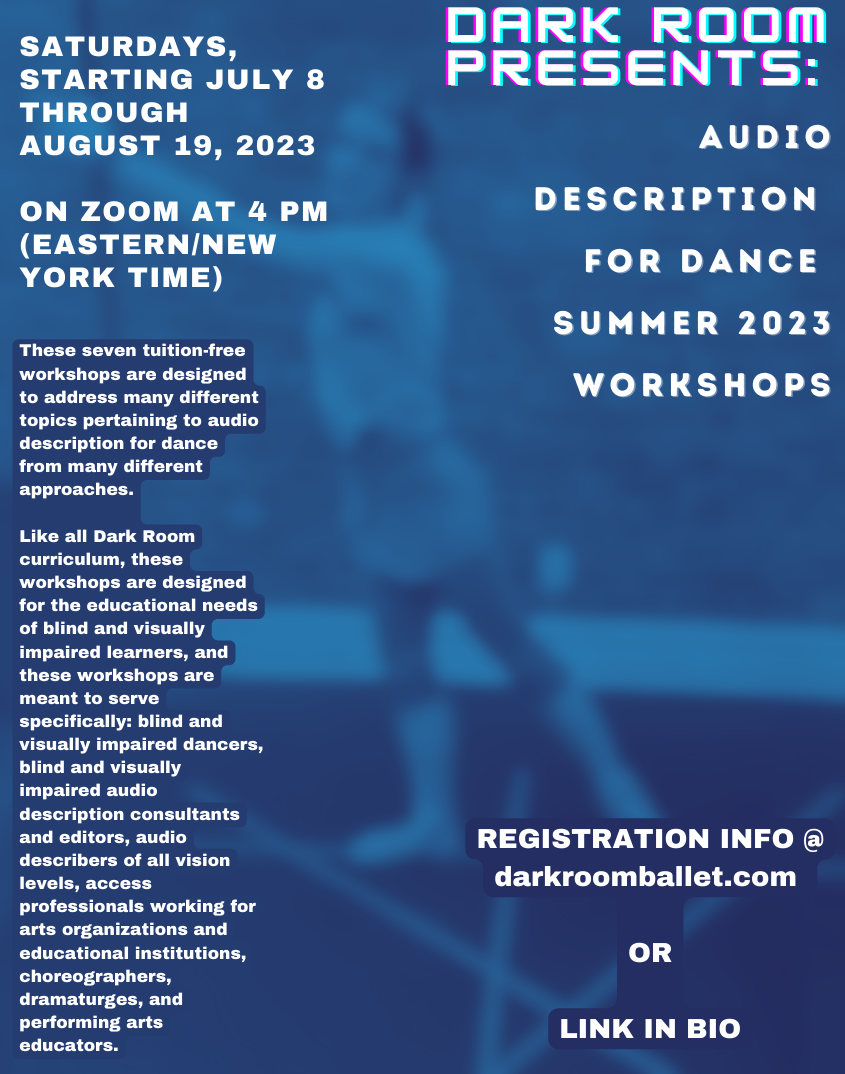Announcing a new series of three no-diagram anatomy workshops open to all (with priority given to blind and visually impaired students), no prior experience required.
Sponsored by Movement Research, all workshops take place online via Zoom.
To register for any or all workshops, please write to info@darkroomballet.com as soon as possible to complete the registration process.
Saturday, May 18, 2024:
The Maxillofacial Complex (Face and Jaw Class)
This highly detailed workshop is a complete analysis of the underlying structures, biomechanics, and muscular actions in the human face and jaw. In this workshop, we will use movement, touch, facial expressions, and conversations to not only cultivate scientific knowledge related to the maxillofacial complex, but also initiate a higher degree of body awareness and neurological learning pertaining to how and why our faces move the way that they do. Evolutionary history and the marvels of human variation will also be addressed in this workshop. No prior knowledge of human anatomy, dance, or self-audio description are required to participate, but all students will come away with deep anatomical knowledge, reduced movement anxiety, and tools to start learning how to talk about movement in a visceral way. Let’s get right down to the real nitty gritty!
Material covered in this workshop will include:
- The underlying structures of the maxillofacial complex
- The biomechanical processes of the face and jaw
- The muscles associated with facial expressions
- The muscles associated with mastication
All students will receive the complete script of the workshop two days beforehand, and the script can be reviewed either before or after the workshop.
This workshop is designed for the educational needs of blind and visually impaired people and does not use diagrams.
Saturday, May 25, 2024:
The Auditory System (How We Hear)
This highly detailed workshop is a complete analysis of the physical structures involved with hearing, as well as an overview of how the sensory neurons involved with hearing work and what sound actually is. In this workshop, we will use movement, touch, listening activities, and conversations to not only cultivate scientific knowledge related to the auditory system, but also initiate a higher degree of body awareness and neurological learning pertaining to how to listen in a truly active, informative way. Evolutionary history and the marvels of human variation will also be addressed in this workshop. No prior knowledge of human anatomy, dance, or self-audio description are required to participate, but all students will come away with deep anatomical knowledge, reduced movement anxiety, and tools to start learning how to talk about movement in a visceral way. Let’s get right down to the real nitty gritty!
Material covered in this workshop will include:
- The physical structures of the auditory complex (bones, muscles, connective tissue)
- How sensory neurons provide us information about sound
- An understanding of what sound actually is
- Strategies to develop metacognition around our listening skills
All students will receive the complete script of the workshop two days beforehand, and the script can be reviewed either before or after the workshop.
This workshop is designed for the educational needs of blind and visually impaired people and does not use diagrams.
Saturday, June 1, 2024:
The Genu-Femoral Complex (Knee and Thigh Class)
This highly detailed workshop is a complete analysis of the bones, muscles, connective tissues, biomechanics, and nerves of the knee and thigh. In this workshop, we will use movement, touch, and conversations to not only cultivate scientific knowledge related to the genu-femoral complex, but also initiate a higher degree of body awareness and neurological learning surrounding this extremely strong but extremely fragile region of the human body. This workshop will address injury prevention and injury recovery! Evolutionary history and the marvels of human variation will also be addressed in this workshop. No prior knowledge of human anatomy, dance, or self-audio description are required to participate, but all students will come away with deep anatomical knowledge, reduced movement anxiety, and tools to start learning how to talk about movement in a visceral way. Let’s get right down to the real nitty gritty!
Material covered in this workshop will include:
- The bones of the genu-femoral complex
- The muscles and biomechanical functions of the genu-femoral complex
- The connective tissues of the genu-femoral complex
- The nerve and nerve complexes of the genu-femoral complex
- Ways of reducing injury risk and addressing injuries compassionately
All students will receive the complete script of the workshop two days beforehand, and the script can be reviewed either before or after the workshop.
This workshop is designed for the educational needs of blind and visually impaired people and does not use diagrams.
Image description:
A promotional graphic for the upcoming “No Diagram Anatomy” cycle is divided into six colorful sections, each featuring a simplified illustration of a part of the human skeletal system (not specific to the classes themselves):
In the top left yellow square is a green pelvis
In the top center blue square is a yellow skull
In the top right yellow skull, a pink ribcage
The bottom left blue square shows a red elbow joint
The bottom center red square shows part of a yellow vertebra
The bottom right green square shows part of a yellow femur bone
In front of the image, a white rectangle with black text reads:
No Diagram Anatomy
Dark Room Ballet with Krishna Washburn
Spring 2024





